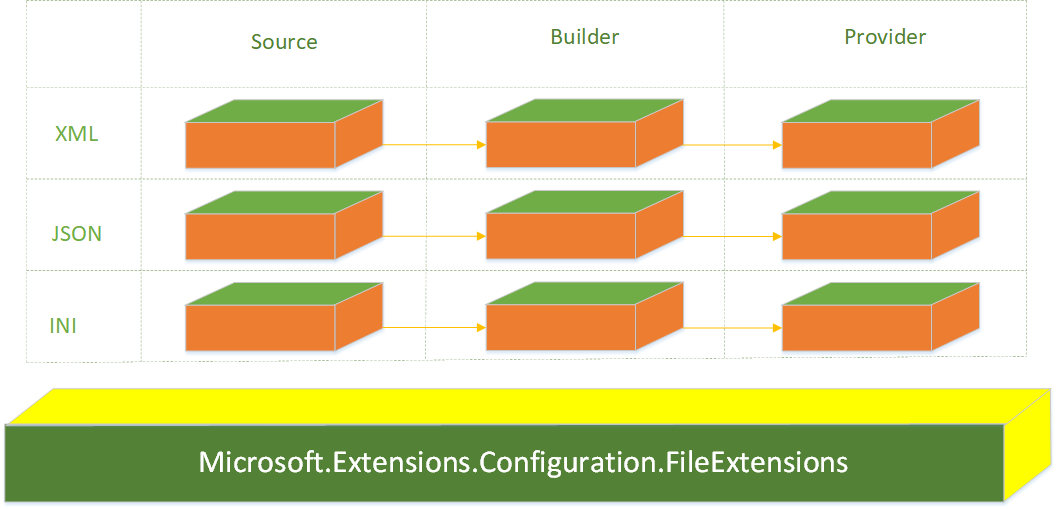.NET Core 3.0之深入源码理解Configuration(二)
文件型配置基本内容
上一篇文章讨论了Configuration的几个核心对象,本文继续讨论Configuration中关于文件型配置的相关内容。相比较而言,文件型配置的使用场景更加广泛,用户自定义配置扩展也可以基于文件型配置进行扩展。如果需要查看上一篇文章,可以点击移步。
.NET Core文件型配置中我们提供了三种主要的实现,分别是JSON、XML、INI,请查看下图
由图可知,这三种配置的实现方式是一样的,当然了其他的配置比如命令行配置、环境变量配置等也是大同小异,理解了改配置类型的实现方式,后面我们再扩展基于Consul或者ZK的实现,就非常简单了。
文件型配置的抽象扩展
文件型配置的抽象扩展位于Microsoft.Extensions.Configuration.FileExtensions组件中,该扩展是一个基础实现。不过其命名空间是Microsoft.Extensions.Configuration,而Micros oft.Extensions.Configuration扩建本身又是整个.NET Core Configuration的基础实现。将File扩展独立于外部,体验了.NET Core的模块化设计。
FileConfigurationSource
Configuration.FileExtensions组件中,FileConfigurationSource是继承于IConfigurationSource的一个抽象类,包含了一个IConfigurationProvider类型的抽象方法,如下所示
1: /// <summary>
2: /// Builds the <see cref="IConfigurationProvider"/> for this source.
3: /// </summary>
4: /// <param name="builder">The <see cref="IConfigurationBuilder"/>.</param>
5: /// <returns>A <see cref="IConfigurationProvider"/></returns>
6: public abstract IConfigurationProvider Build(IConfigurationBuilder builder);
该抽象类中还包括了几个比较重要的参数,分别用于配置性行为、文件内容访问以及异常处理。
string Path:文件的路径
bool Optional:标识加载的文件是否是可选的
bool ReloadOnChange:如果文件发生修改,是否重新加载配置源
int ReloadDelay:加载延迟,单位是毫秒,默认是250毫秒
IFileProvider FileProvider:用于获取文件内容
Action<FileLoadExceptionContext> OnLoadException:文件加载异常处理
该类对FileProvider有特殊处理,就是如果没有提供FileProvider实例,则会基于绝对路径,在最近的现有目录中创建物理文件提供程序。源码如下,
1: /// <summary>
2: /// If no file provider has been set, for absolute Path, this will creates a physical file provider
3: /// for the nearest existing directory.
4: /// </summary>
5: public void ResolveFileProvider()
6: {
7: if (FileProvider == null &&
8: !string.IsNullOrEmpty(Path) &&
9: System.IO.Path.IsPathRooted(Path))
10: {
11:
var directory = System.IO.Path.GetDirectoryName(Path);
12: var pathToFile = System.IO.Path.GetFileName(Path);
13: while (!string.IsNullOrEmpty(directory) && !Directory.Exists(directory))
14: {
15: pathToFile = System.IO.Path.Combine(System.IO.Path.GetFileName(directory), pathToFile);
16: directory = System.IO.Path.GetDirectoryName(directory);
17: }
18: if (Directory.Exists(directory))
19: {
20: FileProvider = new PhysicalFileProvider(directory);
21: Path = pathToFile;
22: }
23: }
24: }
FileConfigurationProvider
该类是继承于ConfigurationProvider的抽象类,是从文件系统加载配置的基类,同时还继承了IDisposable,其抽象方法是Load方法,用于从当前的Provider中以Stream方式加载数据
1: /// <summary>
2: /// Loads this provider's data from a stream.
3: /// </summary>
4: /// <param name="stream">The stream to read.</param>
5: public abstract void Load(Stream stream);
该类还重写了ConfigurationProvider的Load方法,并对文件加载中的异常做了处理,Data属性在前文有提到过,此处不再做其他说明。方法源码如下所示:
1: private void Load(bool reload)
2: {
3: var file = Source.FileProvider?.GetFileInfo(Source.Path);
4: if (file == null || !file.Exists)
5: {
6: if (Source.Optional || reload) // Always optional on reload
7: {
8: Data = new Dictionary<string, string>(StringComparer.OrdinalIgnoreCase);
9: }
10: else
11: {
12: var error = new StringBuilder($"The configuration file '{Source.Path}' was not found and is not optional.");
13: if (!string.IsNullOrEmpty(file?.PhysicalPath))
14: {
15: error.Append($" The physical path is '{file.PhysicalPath}'.");
16: }
17: HandleException(new FileNotFoundException(error.ToString()));
18: }
19: }
20: else
21: {
22: // Always create new Data on reload to drop old keys
23: if (reload)
24: {
25: Data = new Dictionary<string, string>(StringComparer.OrdinalIgnoreCase);
26: }
27: using (var stream = file.CreateReadStream())
28: {
29: try
30: {
31: Load(stream);
32: }
33: catch (Exception e)
34: {
35: HandleException(e);
36: }
37: }
38: }
39: // REVIEW: Should we raise this in the base as well / instead?,通过注释,我们可以知道OnReload()方法可能会在新版中发生变化
40: OnReload();
41: }
42:
43: /// <summary>
44: /// Loads the contents of the file at <see cref="Path"/>.
45: /// </summary>
46: /// <exception cref="FileNotFoundException">If Optional is <c>false</c> on the source and a
47: /// file does not exist at specified Path.</exception>
48: public override void Load()
49: {
50: Load(reload: false);
51: }
另外它还有一个特殊方法,就是参数类型为FileConfigurationSource的构造函数,其主要功能是监控文件,并在FileConfigurationSource.ReloadDelay设置的时间里重新加载文件并返回一个IDisposable类型的值,以下是该构造函数的源码:
1: /// <summary>
2: /// Initializes a new instance with the specified source.
3: /// </summary>
4: /// <param name="source">The source settings.</param>
5: public FileConfigurationProvider(FileConfigurationSource source)
6: {
7: if (source == null)
8: {
9: throw new ArgumentNullException(nameof(source));
10: }
11: Source = source;
12:
13: if (Source.ReloadOnChange && Source.FileProvider != null)
14: {
15: _changeTokenRegistration = ChangeToken.OnChange(
16: () => Source.FileProvider.Watch(Source.Path),
17: () => {
18: Thread.Sleep(Source.ReloadDelay);
19: Load(reload: true);
20: });
21: }
22: }
FileConfigurationExtensions
该类是一个静态类,其提供了的多个扩展方法,主要基于
- IConfigurationBuilder
- IFileProvider
- Action<FileLoadExceptionContext>
包括主要用于设置或获取IFileProvider对象,前文有介绍过,是存储于字典之中,需要注意的是,在Get的时候如果字典中并不存在IFileProvider对象,则会实例化一个PhysicalFileProvider对象出来,该类位于Microsoft.Extensions.FileProviders.PhysicalFileProvider
1: /// <summary>
2: /// Sets the default <see cref="IFileProvider"/> to be used for file-based providers.
3: /// </summary>
4: /// <param name="builder">The <see cref="IConfigurationBuilder"/> to add to.</param>
5: /// <param name="fileProvider">The default file provider instance.</param>
6: /// <returns>The <see cref="IConfigurationBuilder"/>.</returns>
7: public static IConfigurationBuilder SetFileProvider(this IConfigurationBuilder builder, IFileProvider fileProvider)
8: {
9: if (builder == null)
10: {
11: throw new ArgumentNullException(nameof(builder));
12: }
13:
14: builder.Properties[FileProviderKey] = fileProvider ?? throw new ArgumentNullException(nameof(fileProvider));
15: return builder;
16: }
17:
18: /// <summary>
19: /// Gets the default <see cref="IFileProvider"/> to be used for file-based providers.
20: /// </summary>
21: /// <param name="builder">The <see cref="IConfigurationBuilder"/>.</param>
22: /// <returns>The <see cref="IConfigurationBuilder"/>.</returns>
23: public static IFileProvider GetFileProvider(this IConfigurationBuilder builder)
24: {
25: if (builder == null)
26: {
27: throw new ArgumentNullException(nameof(builder));
28: }
29:
30: if (builder.Properties.TryGetValue(FileProviderKey, out object provider))
31: {
32: return provider as IFileProvider;
33: }
34:
35: return new PhysicalFileProvider(AppContext.BaseDirectory ?? string.Empty);
36: }
为指定路径的物理文件设置文件型Provider,该方法同样基于PhysicalFileProvider,并返回IConfigurationBuilder对象
1: /// <summary>
2: /// Sets the FileProvider for file-based providers to a PhysicalFileProvider with the base path.
3: /// </summary>
4: /// <param name="builder">The <see cref="IConfigurationBuilder"/> to add to.</param>
5: /// <param name="basePath">The absolute path of file-based providers.</param>
6: /// <returns>The <see cref="IConfigurationBuilder"/>.</returns>
7: public static IConfigurationBuilder SetBasePath(this IConfigurationBuilder builder, string basePath)
8: {
9: if (builder == null)
10: {
11: throw new ArgumentNullException(nameof(builder));
12: }
13:
14: if (basePath == null)
15: {
16: throw new ArgumentNullException(nameof(basePath));
17: }
18:
19: return builder.SetFileProvider(new PhysicalFileProvider(basePath));
20: }
以及异常处理,可以看到其异常处理也会存放于字典中,如果字典中找不到,就会返回空,这个地方如果直接使用,需要注意空指针问题。
1: /// <summary>
2: /// Sets a default action to be invoked for file-based providers when an error occurs.
3: /// </summary>
4: /// <param name="builder">The <see cref="IConfigurationBuilder"/> to add to.</param>
5: /// <param name="handler">The Action to be invoked on a file load exception.</param>
6: /// <returns>The <see cref="IConfigurationBuilder"/>.</returns>
7: public static IConfigurationBuilder SetFileLoadExceptionHandler(this IConfigurationBuilder builder, Action<FileLoadExceptionContext> handler)
8: {
9: if (builder == null)
10: {
11: throw new ArgumentNullException(nameof(builder));
12: }
13:
14: builder.Properties[FileLoadExceptionHandlerKey] = handler;
15: return builder;
16: }
17:
18: /// <summary>
19: /// Gets the default <see cref="IFileProvider"/> to be used for file-based providers.
20: /// </summary>
21: /// <param name="builder">The <see cref="IConfigurationBuilder"/>.</param>
22: /// <returns>The <see cref="IConfigurationBuilder"/>.</returns>
23: public static Action<FileLoadExceptionContext> GetFileLoadExceptionHandler(this IConfigurationBuilder builder)
24: {
25: if (builder == null)
26: {
27: throw new ArgumentNullException(nameof(builder));
28: }
29:
30: if (builder.Properties.TryGetValue(FileLoadExceptionHandlerKey, out object handler))
31: {
32: return handler as Action<FileLoadExceptionContext>;
33: }
34:
return null;
35: }
该类还有两个静态私有变量,指定了文件Provider的Key以及文件加载异常处理Key。
1: private static string FileProviderKey = "FileProvider";
2: private static string FileLoadExceptionHandlerKey = "FileLoadExceptionHandler";
总结
文件型配置还依赖于.NET Core的其他组件Microsoft.Extensions.FileProviders和Microsoft.Extensions.Primitives。
FileProviders组件提供了文件处理的一般方法,Primitives组件提供了监控机制,同时还包括两个比较重要的结构体StringValues和StringSegment,本文暂时不做讨论,有兴趣的朋友,可以自行查看该组件源码。
以上为本篇文章的主要内容,希望大家多提意见,如果喜欢记得点个推荐哦
作者: 艾心
出处: https://www.cnblogs.com/edison0621/
本文版权归作者和博客园共有,欢迎转载,转载时保留原作者和文章地址即可。




【推荐】国内首个AI IDE,深度理解中文开发场景,立即下载体验Trae
【推荐】编程新体验,更懂你的AI,立即体验豆包MarsCode编程助手
【推荐】抖音旗下AI助手豆包,你的智能百科全书,全免费不限次数
【推荐】轻量又高性能的 SSH 工具 IShell:AI 加持,快人一步
· 如何编写易于单元测试的代码
· 10年+ .NET Coder 心语,封装的思维:从隐藏、稳定开始理解其本质意义
· .NET Core 中如何实现缓存的预热?
· 从 HTTP 原因短语缺失研究 HTTP/2 和 HTTP/3 的设计差异
· AI与.NET技术实操系列:向量存储与相似性搜索在 .NET 中的实现
· 周边上新:园子的第一款马克杯温暖上架
· Open-Sora 2.0 重磅开源!
· 分享 3 个 .NET 开源的文件压缩处理库,助力快速实现文件压缩解压功能!
· Ollama——大语言模型本地部署的极速利器
· DeepSeek如何颠覆传统软件测试?测试工程师会被淘汰吗?